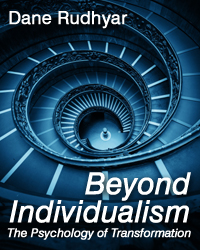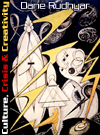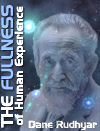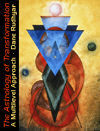Beyond Individualism
The Psychology of Transformation
by Dane Rudhyar
PART TWO:
THE SOCIAL-COLLECTIVE MODE
6. The Ideal of Social Plenitude
c. The Relative Failure of Western Society
How to determine which individual person naturally belongs to which basic type of function is evidently a difficult problem at the present state of human evolution and consciousness; yet it should be interesting to note that the political life of the United States is based on a somewhat similar differentiation of the legislative, the executive (with all its various departments and modes of social control), and the judiciary. Unfortunately, this threefold principle of organization is understood only at the political level of power, and in terms of 'checks and balances' in the use of that power. The threefold principle should be seen operating as well, and more basically, at the level of the individualized consciousness of the people belonging to the sociocultural whole.
At this level, no sane and objective person would deny the existence of fundamental and natural differences between the needs, desires and goals of individuals. Any attempt to eradicate and bring to a level of uniformity these psychological differences —related to differences in biopsychic temperament yet transcending them—is doomed to failure. What should be done instead is —I repeat—to allow each basic mode of functional activity to unfold according to its own rhythm and at its most characteristic, most productive, and most meaningful level, yet within the limitations of the special character of the whole in which it participates.
An example of the possibility of plenary multi-level group organization can be drawn from the world of music; for in the great motets of the early Renaissance we have an archetypal presentation of an evolving organization according to which four or eight melodic lines flow together in relative independence in polyphonic interplay. Yet this polyphonic structure is also harmonic, for all the notes of the motet belong to one particular 'tonality', representing the principle of socio-cultural integration.
The classical European culture nevertheless was unable to bring such a model of organization to a condition of plenary fulfillment because the composers of the motets paid too much attention to the intellectual element of the rigidly determined 'form' of the whole. They stressed the abstract and quantitative character rather than the livingness and quality of the musical units—the notes—because the men and women who sang these notes were not allowed by their dogmatic religion or their politically totalitarian society to develop their potential of experience and self-actualization as fully individualized and richly living human beings.
The same thing occurred at the socio-political level during the 18th century when the men of "the Enlightenment"—a very restricted and intellectualized enlightenment!—could only think of 'democracy' in terms of an equally abstract and quantitative egalitarianism, while glorifying "Reason" and a mechanistic vision of a purely material universe. The legacy of such a sociocultural philosophy inevitably produced the critical situation the whole of mankind is now facing. It had to be critical because the intellectual and individualizing functions of the third order were given, at least in theory, a nearly exclusive kind of prominence which perverted the nature of the functions of the first and second orders, and made it extremely difficult for the functions of the fourth order to play a significant and transformative role. Thus, because the intellect operates most spectacularly in the realm of physical matter which it can freely analyze and manipulate, we have inherited, together with increased physical wellbeing, the curse of unbridled industrialization and of a quantitative type of existence measured by statistics and balance-sheets in which the human person is merely a number, unrelated to functional activity and, what is more, to a particular state of consciousness and potentiality.
The plenary society I envision can only validly and successfully operate if, in terms of the dialectical process of human evolution, it truly constitutes a synthesis; and a true synthesis has to include—in a harmonized, transformed, and repolarized condition—all that was added to the original thesis during the phase of antithesis. What was added during the Age of Differentiation and Conflicts (the four basic stages of which were outlined in the preceding chapter) is essentially a fully conscious, sharply defined, precisely effective and clearly transferable realization of the place and purpose of physical and psychological human activities—in all their forms—and also of the negative possibilities material existence presents to a centralizing core of consciousness. When this core of consciousness has to operate in the midst of the type of physical/material conditions found in the Earth's biosphere, and as the centralizing and individualizing center for biological energies, it almost inevitably functions at first as an exclusivistic, possessive, proud, yet insecure ego. It is only when—after many serious and perhaps devastating crises and much suffering—functions of the fourth order begin to operate that the true individualizing center, the "I", can be heard without 'static' induced by disharmonic brain activity.
Only then can the individual person find his or her place within the 'greater Whole' of humanity—a whole seen for the first time as an integral but immensely complex organism. It is an organic Whole, but because it is 'human' it has within itself the possibility of radically transforming itself. There is no fate-ordained dead end for humanity, no more than for the individual center of consciousness within any human being. Activity may cease when the limiting boundary of its cycle at a particular level is reached; but the mind-seed of consciousness is drawn into the field of operation of the greater whole of which it has been a focalized form of expression.
The concepts of fullness of harmonic activity—what I call 'plenitude' of being—should not imply the idea of finality. A holistic philosophy of activity can accept neither absolute end nor beginning. Time is cyclic. Space is infinite. Motion unceasing. Whatever reaches the state of plenitude—be it an individual person, mankind-as-a-whole, or a galaxy—finds itself at the thresh-hold of emptiness. The consciousness that truly experiences plenitude, in that very moment, must know the ineradicable longing for greater fullness of being within a larger field of activity. The potentiality of rebirth is inherent in every death; but as far as we know, only human beings—and beings greater than man— can, for an instant, consciously perceive in a flash of light the potency of rebirth in the darkness of the closing cycle of physical existence.
Christian mystics have spoken of the "Dark Night of the Soul" that so often follows great experiences of union with the Divine—when every mode of activity is drawn into the center of the human field and a self-transcending contact is established between this center and the center of an all-encompassing Greater Whole to which we attribute the character of divinity. Buddhist philosophers stress the experience of the Void. This Dark Night, this Void, are the unavoidable polarities of the experience of illumination and plenitude. But in that moment, when the feeling of plenitude changes into the hollow sense of emptiness, the potentiality of rebirth is released. In most cases, however, the formation of consciousness and the activity patterns that led to the moment of plenitude oppose a strong power of inertia to the movement toward rebirth. A more or less long period of disintegration of the past therefore has to follow.
We have seen this process at work during the periods of transition between the various stages of development of the individual person and of human society. But when the fourth order of functions are fully developed in a person, and the now only ideal state of truly plenary society is reached, this will not be the end. The Earth itself is but a part of the solar system; and encompassing all solar systems is the galaxy. Still beyond, the present cosmos of which we are physically aware extends. Moreover, there undoubtedly are other states of substance beyond what we call physical matter. There are other modes of activity and forms of consciousness now inconceivable to us.
Ultimately, we have to postulate infinity as That out af which all finite fields of activity emerge. We have to do so intellectually as long as we think in terms of change, activity, relationship between wholes of existence and therefore time, space, and motion. We may also 'feel' the mysterious 'Presence' of infinity, not only surrounding but pervading us, in moments of radical transformation when our deepest sense of finiteness collapses, and we find ourselves shipwrecked in the immense Ocean of potentiality.
In such moments, the devoted Christian finds strength in the Biblical assertion that "with God all things are possible." There are many ways of envisioning "God." Essentially, for whomever believes in the validity of the cyclocosmic world-view presented here, God is the undefeatable and ever-present power of transformation that makes it possible for smaller fields of activity and consciousness to become transformed into ever vaster fields. God is also the power which insures that every release of cosmic and life energy occurs as a unit within which a structural principle operates, maintaining that unit whole and endowing it with consciousness. To operate as a harmoniously functioning whole; to transform oneself stage after stage according to the encompassing rhythm of a Greater Whole; and to be able to do so consciously through a mysterious attunement of one's center with the center of the Greater Whole: this is the meaning and challenge of human existence.
Copyright © 1979 by Dane Rudhyar.
All Rights Reserved.
See Notices for full copyright statement and conditions of use.
Web design copyright © 2000-2004 by Michael R. Meyer.
All Rights Reserved.






